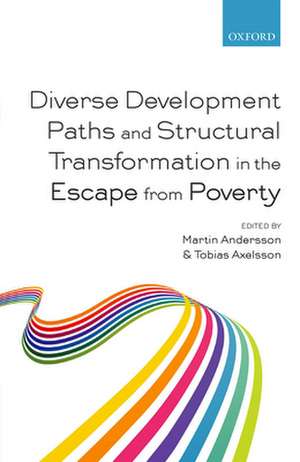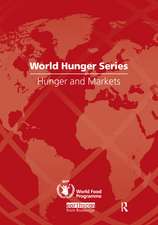Diverse Development Paths and Structural Transformation in the Escape from Poverty
Editat de Martin Andersson, Tobias Axelssonen Limba Engleză Hardback – 21 apr 2016
Preț: 643.29 lei
Preț vechi: 922.79 lei
-30% Nou
Puncte Express: 965
Preț estimativ în valută:
123.11€ • 128.19$ • 104.04£
123.11€ • 128.19$ • 104.04£
Carte tipărită la comandă
Livrare economică 27 februarie-05 martie
Preluare comenzi: 021 569.72.76
Specificații
ISBN-13: 9780198737407
ISBN-10: 0198737408
Pagini: 302
Ilustrații: 16 Figures and 18 Tables
Dimensiuni: 179 x 241 x 24 mm
Greutate: 0.58 kg
Editura: OUP OXFORD
Colecția OUP Oxford
Locul publicării:Oxford, United Kingdom
ISBN-10: 0198737408
Pagini: 302
Ilustrații: 16 Figures and 18 Tables
Dimensiuni: 179 x 241 x 24 mm
Greutate: 0.58 kg
Editura: OUP OXFORD
Colecția OUP Oxford
Locul publicării:Oxford, United Kingdom
Recenzii
Convergence, structural change, institutions, capabilities such keywords form the skeleton of contemporary development theory. This fascinating book adds concrete, historical flesh to the concepts. It demonstrates the diversity of development paths and provides hope of continued economic advancement, even if under different models than have prevailed to date.
This excellent volume brings together leading scholars with interests in long term economic dynamics in the borderland between economic history and development economics to provide a thought-provoking overview of the patterns of economic development and an agenda for policy. It will be valuable to policy-makers and academics alike.
One of the most intellectually exciting areas of social science is the fusion of economic history and economic development. This important book brings some of the main practitioners of this revolution together to reflect on the progress made.
Structural transformation of agrarian economies has been recognised as essential to escaping poverty. It is one of the few generalisations that development economists can confidently make! Perhaps because of this, policy analysts have been overly prescriptive and dogmatic about the path a given country should take, holding up miracle cases as universal models. The great feature of this book is to highlight the context-dependence, diversity, and dynamism of development pathways. Bringing the insights of leading economic historians to the practical issues of agricultural and industrial development, this collection examines the contingency of the transformation process across three continents. The result is a deeply insightful contribution to both economic history and development policy.
The book, written by experts on the subject, will be of great interest to researchers of development economics and to economic historians; there are even chapters that can be of interest to a less specialized public, because they treat these topics in a rigorous but clear and simple way.
This excellent volume brings together leading scholars with interests in long term economic dynamics in the borderland between economic history and development economics to provide a thought-provoking overview of the patterns of economic development and an agenda for policy. It will be valuable to policy-makers and academics alike.
One of the most intellectually exciting areas of social science is the fusion of economic history and economic development. This important book brings some of the main practitioners of this revolution together to reflect on the progress made.
Structural transformation of agrarian economies has been recognised as essential to escaping poverty. It is one of the few generalisations that development economists can confidently make! Perhaps because of this, policy analysts have been overly prescriptive and dogmatic about the path a given country should take, holding up miracle cases as universal models. The great feature of this book is to highlight the context-dependence, diversity, and dynamism of development pathways. Bringing the insights of leading economic historians to the practical issues of agricultural and industrial development, this collection examines the contingency of the transformation process across three continents. The result is a deeply insightful contribution to both economic history and development policy.
The book, written by experts on the subject, will be of great interest to researchers of development economics and to economic historians; there are even chapters that can be of interest to a less specialized public, because they treat these topics in a rigorous but clear and simple way.
Notă biografică
Martin Andersson is Associate Professor in Economic History at Lund University. He has worked as a consultant for the World Bank and has been a Marie Curie post-doc at EUI in Florence and a visiting scholar at UC Berkeley. His research interests include agricultural development and the relation between economic growth, poverty reduction, and distribution of income in the developing world. He is co-editor of Development and Structural Change in Asia-Pacific (Routledge, 2003). Tobias Axelsson is Assistant Professor in the Department of Economic History at Lund University. His research is on agricultural transformation processes and colonial origins of inequality. He has been a guest researcher at ISEAS in Singapore and a guest research fellow at the International Institute for Asian Studies, Leiden. Dr Axelsson is a co-founder of the Bachelor programme in development studies at Lund University.









